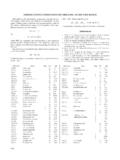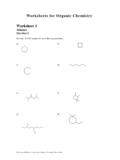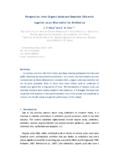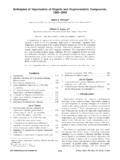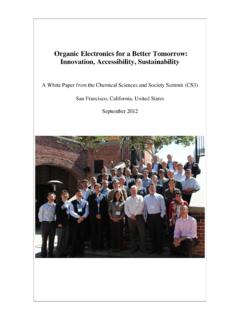Transcription of Organic peroxide’s safe handling and use - …
1 AB CHEMITRANS, 333, Bohum n,CZ 735 52; phone +420 608 944 257; Organic peroxide s safe handling and use1. IntroductionChemically Organic peroxides are meta-stable compounds for there is oxygen oxygenLinkage in the molecular structure. Under conditions of heating or activation, this oxygen-oxygenBond cleaves to form active free radicals, and these radicals can initiate polymerization or curingEasy. Organic peroxides are used in plastics industry as curing agents for thermoset resins,initiatorFor free radical polymerization and cross-linking agents for elastomers and polyethylene.
2 They aredangerous for their high reactivity, so we must treat or handle them correctly. The category of Organic peroxides list DIACYL PEROXIDESDry benzyl peroxide and pure MEK peroxide are shock and friction sensitive. Except for benzyl peroxide allcommercial diacyl peroxides are formulated to be non-shock or non-friction sensitive and are very safe if handled andstored properly. Examples include the wetted and paste forms of benzoyl PEROXYESTERSP eroxyesters are quite stable at their recommended storage temperatures. Some peroxyester can freeze.
3 Allowing themto warm at a temperature not above the maximum required can thaw frozen PEOXYDICARBONATESP eroxydicarbonates are thermally unstable compounds. At their recommended storage temperatures however they arequite safe . At higher than these temperatures, decomposition will occur, in some cases rather DIALKYL PEROXIDESA mong the commercially available dialkyl peroxides. Di-t-Butyl peroxides have a low flash point and its vapors arehighly flammable. All other dialkyl peroxides have relatively high flash points, but once ignited, will burn vigorouslyand are difficult to KETONE PEROXIDESThis kind of peroxides is subject to decomposition through chemical action and is particularly sensitive to metallicsalts.
4 They are widely used as room temperature catalysts for curing polyester resins, which contain accelerators suchas cobalt naphthenate and cobalt/tertiary amine combinations. Direct mixtures of the peroxides and the acceleratormay decompose with violence and every effort should be made to eliminate any possibility of direct contact because ofthe wide range of contaminants which can interact with ketone peroxides, good housekeeping practices should bestrictly PEROXYKETALSP eroxyketals are extremely sensitive to acid contamination, which cause rapid decomposition releasing flammablevapors, which may self.
5 HYDROPEROXIDESC ommercial formulations of Hydro peroxides as supplied by Lanzhou Auxiliary Agent Plant are not shock hydro peroxides and hexane are considered too shock sensitive forcommercial Source of HazardsA wide variety of Organic peroxides are offered commercially to meet the sophisticated needs of polymermanufactures. Among them the product representing of the classes are listed in table I. (Note: MEK or ketoneperoxides are a mixture of peroxides and hydroperoxides).Peroxyesters peroxydecarbonates dialkyl peroxidesROOCROROCOOCOROOROORt-butyl perbenzoate di-2-ethylhexyl peroxy- di-t-butyl peroxideDicarbonate 2,5-dimethyl-2,5-bis (t-butyl-peroxy)hexanet-butyl peroxypivalate di-sec-butyl peroxy-t-butyl peroctoate dicarbonate dicumyl peroxidet-butyl peroxy-neodecanoatediacyl peroxides hydroperoxides peroxyketalsRCOOCROOROOOORRCR benzoyl peroxide t-butyl hydroperoxide 1,1-di(t-butyl peroxy)
6 3,3,5-trimethylcyclohexanelauroyl peroxide cumene hydroperoxide 1,1-di(t-butyl peroxy) cyclohexaneThe major causes of peroxide decomposition (source of hazard) are heat, fire, friction, shock and of the common source of these include:Heat Sunlight, loss of refrigeration, radiators or heating elements, hot reaction any open mixing, pumping, grinding, traffic over Dropping, impact during Metal salts, amines, acids, Safety TestsThe major safety characteristics to determine the relative hazard of Organic peroxide include: shock sensitive, theamount of energy released during a decomposition and flash point.
7 The ease of to rate of heat rise,thermal stability, self-accelerated decomposition temperature and ignition or auto ignition Organic peroxide producers safety division of the SPI has developed standardized tests for the determination ofhazard ratings for peroxides .The following is a list and description of these established tests:A. SADT (self accelerating decomposition temperature): This test establishes the lowest2 Temperature at which peroxide , in its largest commercial package, will undergo self-acceleratingdecomposition. The type of decomposition and damage potential are measured, and the severity ofdecomposition is determined.
8 The two parameters having the greatest effect on SADT are rate ofdecomposition and heat loss from the Vessel Test The PVI deals with heat sensitivity, measuring the rate and resultant energy release o thermaldecomposition of peroxides under conditions of rapid heating and partial heat Test This determines the type of decomposition that occurs when peroxidecomposition is heated in a test Sensitivity This test measures the susceptibility of a peroxide to decomposefrom Test This is a measure of the total energy released by peroxide decomposition, when initiated by anexplosive Burring Test This records the ease of.
9 And time to ignition together with burning time and flame height that resultwhen a specified quantity of peroxide is Point This is the temperature at which the product vapors ignite on contact with an open Thermal Stability Test Results are determined by storing peroxide at a constanttemperature for a specified time .The results of this test in terms of weight loss and assay are used as criteria forestablishing storage temperature and shelf life The characteristic of Organic peroxides flammabilityAll Organic peroxides will burn vigorously and once ignited will be difficult to extinguish.
10 The flammability of organicperoxides will bi affected by the decomposition products. Most peroxides decompose with vapors and heat. Suchvapors may be flammable and could be the cause of an density All Organic peroxides are sensitive to heat .If peroxide is heated above a certain temperature; the rate of thedecomposition will increase an uncontrolled manner. This reaction can become violent, releasing largevolumes of hot, flammable StorageExposure to a temperature that can lead to an accelerated decomposition may result in the generation of flammablegasses and in some cases, spontaneous ignition.



